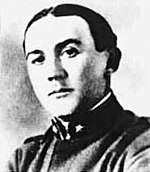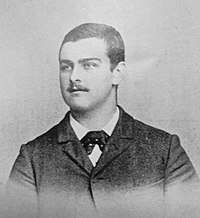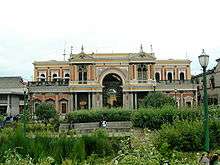Italian Guatemalan
Italian Guatemalans are Guatemalans of Italian ancestry. The Italians contributed in the construction of the country with monuments, buildings and parks, while also contributing at the National Conservatory and in Guatemalan literature.
 President Alejandro Sinibaldi, an Italian Guatemalan | |
| Total population | |
|---|---|
| 4.071 italian residents in Guatemala (2009/31/12) [1], while the number of Guatemalans of Italian descent is around 100,000 - 120,000 | |
| Regions with significant populations | |
| Guatemala city, Quetzaltenango and Zacapa | |
| Languages | |
| Spanish, Italian | |
| Religion | |
| Roman Catholicism and Protestantism | |
| Related ethnic groups | |
| Italians, Guatemalans |
History
The Italian emigration to Guatemala began in the early Republican era of this Central America country. Before the XIX century, during the Spanish colonial era, only a few dozen Italians moved to live in Guatemala. Many of them were religious catholic priests and nuns.
Indeed the Italian emigration toward Guatemala can be divided in 3 waves: the first that was small, the second that created a prosperous colony and the third (or contemporary) that has reached top levels in the Guatemala society (for example: the actual President of Guatemala, Alejandro Giammatei, is descendant from an Italian who moved to Guatemala in the 1930s).
First migration
Vincenzo Filisola occupies Guatemala on behalf of Agustín de Iturbide and ordered to proclaim its independence in 1823; the general Francisco Morazán, of Italian roots, was the second President of the Guatemala Republic". Patricia Spinato[2]
The Italian Vincenzo Filisola (born in Ravello, Italy, in 1789) occupied Guatemala City in 1823 after the formation of the "Federal Republic of Central America" (that included Guatemala) and convened the "Central American congress" which forthwith declared its independence.

Filisola was followed by a small group of Italians, who emigrated from Italy to Guatemala in the first half of the XIX century.
One of the first Italians to come to Guatemala was Geronimo Mancinelli, an Italian coffee farmer who lived in San Marcos (Guatemala) in 1847.[3]
Indeed the first "wave" of Italian immigrants came in 1873, under the government of Justo Rufino Barrios, who made a trip to Europe. He was greatly interested in Italian families to bring to his country: these families had surnames as Bocaletti, Garzaro, Bonnato, Maselli, Comparini and were mostly farmers attracted by the wealth of natural and spacious highlands of Guatemala. Most of them settled in Quetzaltenango and Guatemala City.[4]
However there were also a few hundreds of Italians from Veneto and Tuscany, who were left without help by their immigration agents after they arrived in the Santo Tomás de Castilla port: some died of yellow fever and malaria, which were endemic to the region, but most moved away by 1878. [5]
It is noteworthy to pinpoint that when Barrios was killed on April 1885 in El Salvador, Alessandro Sinibaldi became President of Guatemala for some time even if he was born in Rome in 1814: his father was a wealthy Italian immigrant.
The second wave: a prosperous Italian colony

The first Italian colony suffered failure for lack of incentives. But in the early 1880, came another wave of Italian immigrants, within the government of Justo Rufino Barrios. This wave of immigrants was different from the previous one, since in this group arrived some writers, painters, sculptors, musicians, scientists and also a few wealthy families.[6]
By 1900, there were more than 1,000 Italians in Guatemala: Italians (under the government of Manuel Estrada Cabrera) built many historical buildings in Guatemala. This occurred in certain areas of Quetzaltenango, Zacapa and Guatemala City that were inhabited mostly by Italians: as a consequence there was a growth of Italo-Guatemalan children. In these years, in the Italian colony there was a huge prosperity: around the year 1930 Guatemala reached its maximum number of Italian residents. Guatemala was the second country with Italians in Central America behind Costa Rica.
Furthermore, according to historian Vittorio Capelli, additionally there were important Italian immigrations -around Guatemala- in Panama and Nicaragua with some small immigrations also in El Salvador and Honduras.[7]
...the Italians in Guatemala were 61 in 1871, 626 in 1881 and 800 in 1888. In 1892 are officially registered (in the Italian Consulate of Guatemala city) 562 Italians, most of them male (355) older than 14 years old and a little less than half (236) analphabets, of whom 425 were born in Guatemala. Patrizia Spinato Bruschi (Universita di Milano)[8]

The Italians were pioneers in bringing European technology into Guatemala (along with the Germans): the first driver throughout Guatemalan history was Dante Nannini Sandoval, descendant of Italian drivers. He was also member of the Italian Air Force during The World War II. In the late 1890s, the first cars that arrived in Guatemala were of Italian origin. Additionally, during the decades between 1870s and 1900s, the Italians built the railway (El Ferrocarril de los Altos)[6]. The Italian Carlo Novella -according to historian Dante Liano- not only participated in this railway construction, but also financed and partially created the port of Champerico (the main port of Guatemala in the Pacific Ocean).

The famous doctor Julio Bianchi, of Italian ancestry, was one of the leaders of the Partido Unionista and was Minister Plenipotentiary to the USA sent by president Carlos Herrera y Luna in 1921[9]. He signed the "Carta 311" in 1944, that was partially responsible for the dictator Jorge Ubico relinquishing power.
During the first decades of the XX century, in Guatemala was reached the maximum number of Italian residents: it was the second country for Italians in Central America, behind Costa Rica.
During this migration, the Italian influence came to the Guatemalan literature, mainly in the late nineteenth century: many indigenous literature of the colonial period was translated by Italian writers. Other writings of Italians in Guatemala reflected the natural and tropical beauty of the country. The Italian editors Aliprandi and Martini painted a vivid picture of the Guatemala's Italian community in 1932.[10]
From this period came the pioneers of the era that gave Guatemala a true socio-economic transformation: the decorators Lutti, Degrandi, Bernasconi, Carmennauti, Scoteti; the sculptor Andrew Gaileitti; the famous architect Porta, who left magnificent works in Quetzaltenango, such as the famous "Pasaje Enriquez"; the doctor Zagrini, a physician and surgeon; the lawyer Julio Drago; the engineers Vittorio Cottone, Enrico Invernizzio and Luigi Paiella, who plotted the Paseo de la Reforma Racetrack, Boulevard Aurora and Elena Avenue.
It is noteworthy to pinpoint that the father & mother of Riccardo Bressani, an italo-guatemalan scientist, came to Guatemala from Italy in this period. Riccardo Bressani was the first scientist to receive the award of the worldwide prestigious Albert Einstein World Award of Science in 1984[11].
By early 1900s, Italian immigrants were an important immigrant group in Guatemala after the Germans, however, unlike the Germans, the Italians never exceeded 10,000 immigrants in Guatemala in any year.
Contemporary migration
The last wave of Italian immigration in Guatemala took place under President Manuel Estrada Cabrera, who wanted to follow the footsteps of his predecessors and led a third emigration of Italian families into Guatemala. In part it succeeded because, by then, the country was a dictatorship. Many came in this period, while some Italians who had arrived under the presidency of Reyna Barrios Barrios left; however, some new contributions came from Italian blood, who put their work and skills at the service of the Guatemalan nation. Among these may be mentioned: Valentine Giordani, Juan Mini and Humberto & Luis Giordani, who worked in the construction of railways and the building of modern houses.[6]
By mid-1930s, Italian immigrants were the second largest immigrant group in Guatemala after the Germans, numbering nearly 6,000. But with the growing Nazi influence in Guatemala by the Germans[12], the government started to reduce & limit the importance to the Italian community (linked partially to Fascism) and the huge prosperity & influence of this colony came to an end during WW2. Some of the 51 Italians of Guatemala who were inscribed in the "Partito fascista" were jailed (but they were a small minority in the more than two thousand Italians living in Guatemala city)[13].
In the 1950s some emigration from Italy, mainly from Calabria and Sicily, was again arriving in Guatemala, but this migration was limited to a few hundreds.
In 2020 was elected President of Guatemala Alejandro Giammattei, whose grandfather came from Italy in the 1930s. He has the double passport (Italian and Guatemalan) because of this ancestor[14].
Demography
The Italian Embassy in Guatemala estimated that nearly 3,800 Italians are living permanently in Guatemala in 2007[15], which makes it the country's third largest European community. Estimates of Guatemalans with Italian ancestry vary from 100,000 to 120,000 (but could be more than 200,000 if considered the Italians who moved to the Spanish America during the early colonial era, changing their name in a Spanish name -like Castiglione in Castillon- because only people from Spain were allowed to settle in the Spanish colonies).
Since 2007 the institution "Internations Guatemala" is in charge of incorporating more foreign residents into Guatemalan culture, including those who are Italian.[16]
_(cropped).jpg)
Notable Italian-Guatemalans
- Alejandro Giammattei, President of Guatemala 2020-2024.
- Stefano Cincotta, is a Guatemalan footballer who plays for Germany.
- Juan Jose Gerardi Conedera, was a Guatemalan Roman Catholic bishop and human rights defender.
- Marco Pappa, is a Guatemalan footballer who plays for the MLS club Seattle Sounders FC. He is a member of the Guatemala national team.
- Dwight Pezzarossi, is a retired professional football forward who last played for Comunicaciones in the Liga Nacional de Guatemala.
- Dante Nannini, the first Guatemalan pilot.
- Ricardo Bressani, scientist inventor of the incaparina.
- Alaíde Foppa, women poet, writer, feminist, art critic, teacher and translator.
- Rodolfo Galeoti Torres, sculptor
Architecture
A number of Italian architects arrived in Guatemala towards the end of the 19th century, giving rise to an Italian-influenced art and architectural movement, particularly in the capital, and several Italian architects oversaw construction projects in Quetzaltenango; these included the Templo de Logia Fénix No. 2, by Alberto Porta.[17]


A group of Italian architects, including Porta and Luigi Lutti, with sculptor Desiderio Scotti, founded the Academy of Municipal Architecture, and were responsible for building many of the most prominent buildings in Quetzaltenango, including the Banco del Occidente and Pasaje Enríquez.[18]

Another important Italian architect was Guido Albani, who reconstructed after the earthquake of 1918 in Guatemala city the "Metropolitan Cathedral" & the temple "Cerrito del Monte"; he also created the "Paraninfo Universitario" of the University San Carlos[19].
References
- Departamento del Interior y Ordenación del Territorio de Italia. "Annuario Statistico 2009" (PDF) (in Italian). pp. 121–129. Retrieved 2009-11-24.
- Patrizia Spinato Bruschi. "L’emigrazione italiana in Guatemala attraverso la letteratura; p.126
- Wagner, Regina (November 2001). Historia del café de Guatemala. Bogota, D,C, Colombia: Anacafe. pp. 203, 207. ISBN 958-96982-8-X. Retrieved 2014-10-27.
- Los múltiples rostros de la diversidad p.61. Informe Nacional de Desarrollo Humano, Guatemala 2005.
- Emigrazione italiana in Guatemala; pg 313 (in Italian)
- italiana La ciudad es como tú, cumple. Cultura
- Cappelli, Vittorio. Nelle altre Americhe. Calabresi in Colombia, Panamà, Costa Rica e Guatemala. La Mongolfiera. Doria di Cassano Jonio, 2004.
- Patrizia Spinato Bruschi: L’emigrazione italiana in Guatemala attraverso la letteratura (in Italian)
- Dr. Julio Bianchi biography
- L’emigrazione italiana in Guatemala attraverso la letteratura University of Milan. By Patrizia Spinato Bruschi
- Founding fathers of the "Einstein World Award of Science"
- La cara europea de Guatemala March 9, 2010.
- "Dizionario biografico degli Italiani in Centroamerica": Fascism in Guatemala; Introduction section
- Giammattei wants to maintain his Italian passport even if now he is President of Guatemala
- The Italian Embassy in Guatemala City
- International Organization for expatriates Italians: Guatemala City
- "Quetzaltenango en la historia" (in Spanish). Quetzaltenango, Guatemala: Municipalidad de Quetzaltenango. Archived from the original on 2015-01-23. Retrieved 2015-04-20.
- Liano, Dante (2003). "Introduzione". Dizionario biografico degli Italiani in Centroamerica (in Italian). Milan, Italy: Vita e Pensiero. pp. xv–xvi. ISBN 9788834309797.
- Architect Guido Albani in Guatemala city